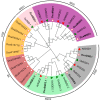Identification and Expression Profiling of Nonphosphorus Glycerolipid Synthase Genes in Response to Abiotic Stresses in Dendrobium catenatum
- PMID: 34199229
- PMCID: PMC8231895
- DOI: 10.3390/plants10061204
Identification and Expression Profiling of Nonphosphorus Glycerolipid Synthase Genes in Response to Abiotic Stresses in Dendrobium catenatum
Abstract
Dendrobium catenatum, a valuable Chinese herb, frequently experiences abiotic stresses, such as cold and drought, under natural conditions. Nonphosphorus glycerolipid synthase (NGLS) genes are closely linked to the homeostasis of membrane lipids under abiotic stress in plants. However, there is limited information on NGLS genes in D. catenatum. In this study, a total of eight DcaNGLS genes were identified from the D. catenatum genome; these included three monogalactosyldiacylglycerol synthase (DcaMGD1, 2, 3) genes, two digalactosyldiacylglycerol synthase (DcaDGD1, 2) genes, and three sulfoquinovosyldiacylglycerol synthase (DcaSQD1, 2.1, 2.2) genes. The gene structures and conserved motifs in the DcaNGLSs showed a high conservation during their evolution. Gene expression profiling showed that the DcaNGLSs were highly expressed in specific tissues and during rapid growth stages. Furthermore, most DcaNGLSs were strongly induced by freezing and post-freezing recovery. DcaMGD1 and DcaSQDs were greatly induced by salt stress in leaves, while DcaDGDs were primarily induced by salt stress in roots. Under drought stress, most DcaNGLSs were regulated by circadian rhythms, and DcaSQD2 was closely associated with drought recovery. Transcriptome analysis also revealed that MYB might be regulated by circadian rhythm and co-expressed with DcaNGLSs under drought stress. These results provide insight for the further functional investigation of NGLS and the regulation of nonphosphorus glycerolipid biosynthesis in Dendrobium.
Keywords: Dendrobium; abiotic stress; circadian regulation; nonphosphorus glycerolipid synthase.
Conflict of interest statement
The authors declare no conflict of interest.
Figures







Similar articles
-
Genome-Wide Identification and Expression Analysis of MYB Transcription Factor Superfamily in Dendrobium catenatum.Front Genet. 2021 Aug 26;12:714696. doi: 10.3389/fgene.2021.714696. eCollection 2021. Front Genet. 2021. PMID: 34512725 Free PMC article.
-
Metabolic Profiling of Terpene Diversity and the Response of Prenylsynthase-Terpene Synthase Genes during Biotic and Abiotic Stresses in Dendrobium catenatum.Int J Mol Sci. 2022 Jun 7;23(12):6398. doi: 10.3390/ijms23126398. Int J Mol Sci. 2022. PMID: 35742843 Free PMC article.
-
Identification and Expression Analysis of WRKY Gene Family in Response to Abiotic Stress in Dendrobium catenatum.Front Genet. 2022 Feb 3;13:800019. doi: 10.3389/fgene.2022.800019. eCollection 2022. Front Genet. 2022. PMID: 35186030 Free PMC article.
-
[Breakthrough in key science and technologies in Dendrobium catenatum industry].Zhongguo Zhong Yao Za Zhi. 2017 Jun;42(12):2223-2227. doi: 10.19540/j.cnki.cjcmm.2017.0102. Zhongguo Zhong Yao Za Zhi. 2017. PMID: 28822173 Review. Chinese.
-
Glucomannan in Dendrobium catenatum: Bioactivities, Biosynthesis and Perspective.Genes (Basel). 2022 Oct 27;13(11):1957. doi: 10.3390/genes13111957. Genes (Basel). 2022. PMID: 36360194 Free PMC article. Review.
Cited by
-
OsMGD1-Mediated Membrane Lipid Remodeling Improves Salt Tolerance in Rice.Plants (Basel). 2024 May 27;13(11):1474. doi: 10.3390/plants13111474. Plants (Basel). 2024. PMID: 38891283 Free PMC article.
-
Label-Free Quantitative Proteomics Unravel the Impacts of Salt Stress on Dendrobium huoshanense.Front Plant Sci. 2022 May 12;13:874579. doi: 10.3389/fpls.2022.874579. eCollection 2022. Front Plant Sci. 2022. PMID: 35646023 Free PMC article.
-
Dendrobium Multi-Omics Reveal Lipid Remodeling in Response to Freezing.Metabolites. 2022 Dec 3;12(12):1216. doi: 10.3390/metabo12121216. Metabolites. 2022. PMID: 36557254 Free PMC article.
References
Grants and funding
LinkOut - more resources
Full Text Sources

